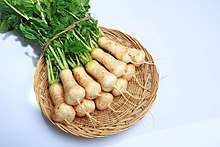Chonggak radish
Chonggakmu or Chonggak radish, also called ponytail radish,[1][2] is a variety of white radish. It is a small radish with many fine roots; of which the entire plant, including the leaves and stems, is used in Korean cuisine.
| Chonggakmu Chonggak radish | |
|---|---|
 | |
| Species | Raphanus raphanistrum |
| Subspecies | R. raphanistrum subsp. sativus |
| Cultivar group | White radish group |
| Origin | Korea |
| Korean name | |
| Hangul | 총각무 |
|---|---|
| Hanja | 總角- |
| Revised Romanization | chonggangmu |
| McCune–Reischauer | ch'onggangmu |
| IPA | [tɕʰoŋ.ɡaŋ.mu] |
Names and etymology
The Korean word chonggakmu (총각무) is a compound of chonggak (총각, "bachelor") and mu (무, "radish"). In premodern Korea, unmarried men and boys pulled their hair into a long braid, while married adult men wore their hair in sangtu, a topknot.[3] On the day of the coming of age ceremony, a boy's braid was undone and it was first made into chonggak, hornlike double topknots, before it was undone again and be made into sangtu.[3] As the shape of chonggak radishes resembled the shape of chonggak hair, it became to be called by the name of chonggak radish.
Description
.jpg)
The taproots of the radish weigh 60–80 grams (2.1–2.8 oz), and are about ten to thirteen times smaller than a regular Korean radish. The upper part of the roots are subterranean stems, from which the long ovate leaves grow. The roots are 8–9 centimetres (3.1–3.5 in) long and the rhizomes are 2–3 centimetres (0.79–1.18 in) long.
Culinary use
Radish greens, called mucheong, is dried to make siraegi or used fresh in cooking. Whole, vertically halved, or quartered chonggak radishes along with the leaves and stems are often used to make kimchi, called chonggak-kimchi, with the seasonings similar to those of kkakdugi (radish kimchi). Chonggak radishes can also be used to make dongchimi, a soupy winter radish kimchi.
_2.jpg) Chonggak-kimchi (chonggak radish kimchi)
Chonggak-kimchi (chonggak radish kimchi).jpg) Dongchimi (radish water kimchi) made with chonggak radishes
Dongchimi (radish water kimchi) made with chonggak radishes
See also
- Korean radish
- Gegeol radish
- Young summer radish
References
- Daley, Bill (21 September 2011). "A mother's lesson: Country living inspires the wife to learn mother's traditional kimchee". Chicago Tribune. Retrieved 24 December 2016.
- Hyman, Vicki (12 October 2011). "Marja Vongerichten's 'Kimchi Chronicles' offers up Korean tastes for the American palate". NJ.com. Retrieved 24 December 2016.
- "머리모양새 이야기" [hairstyle story]. culturecontent.com (in Korean). Korea Creative Content Agency. Retrieved 2016-12-25.